The Ultimate Guide to Training Your Chickens for a Mobile Chicken House
If you have a mobile chicken coop or house, you have experienced some of the difficulties of training new flocks of chickens.
Coop training chickens is never easy, and adding the mobile portion makes training a new flock of chickens more difficult.
Thankfully, there is an efficient way to train your hens for a mobile chicken house!
Over the past ten years, the team at The Mobile Chicken House has successfully taught thousands of hens. We teach new flocks how to roost in the mobile chicken coop at night, how to graze on the organic material in the fields, and how to get the most out of the mobile pastured experience.
And we are ready to teach you everything we have learned over these ten years!
Not only does a well-trained flock make a mobile-pastured egg operation more efficient and require fewer man-hours, but it also keeps the flock healthier and helps give it a longer lifespan.
Keep reading to learn how to train your next flock successfully using a mobile coop or house.

Before You Begin Coop Training Your Chickens
Before we get started, we need to make a few disclaimers to the training method we use.
First, this method is not guaranteed to work perfectly every time. Training any kind of animal always has its unique challenges, and a whole flock of young chickens is no different!
We have used these principles and techniques successfully for over ten years. The methods have worked very well for the majority of our flocks, but we can’t guarantee 100% success with every new group of hens.
Second, be smart and careful when it comes to the weather and temperatures. For example, there are times when we recommend keeping the hens out of the house for long periods to acclimate to the outdoors, but this may not always be smart or possible if the temperatures are too hot or cold.
While we want your flock to learn as quickly as possible, we also want them to remain safe!
And third, please follow the steps carefully and thoroughly. All our instructions are carefully planned out and serve a specific purpose.
Skipping several steps or not following everything results in a lower success rate, and we know what happens then - unruly chickens and unhappy farmers!
By the way, if you have any questions or if something isn’t answered, you can always contact us at The Mobile Chicken House. We would be more than happy to help you.
Alright, now that we have these disclaimers behind us, let’s get to the training!
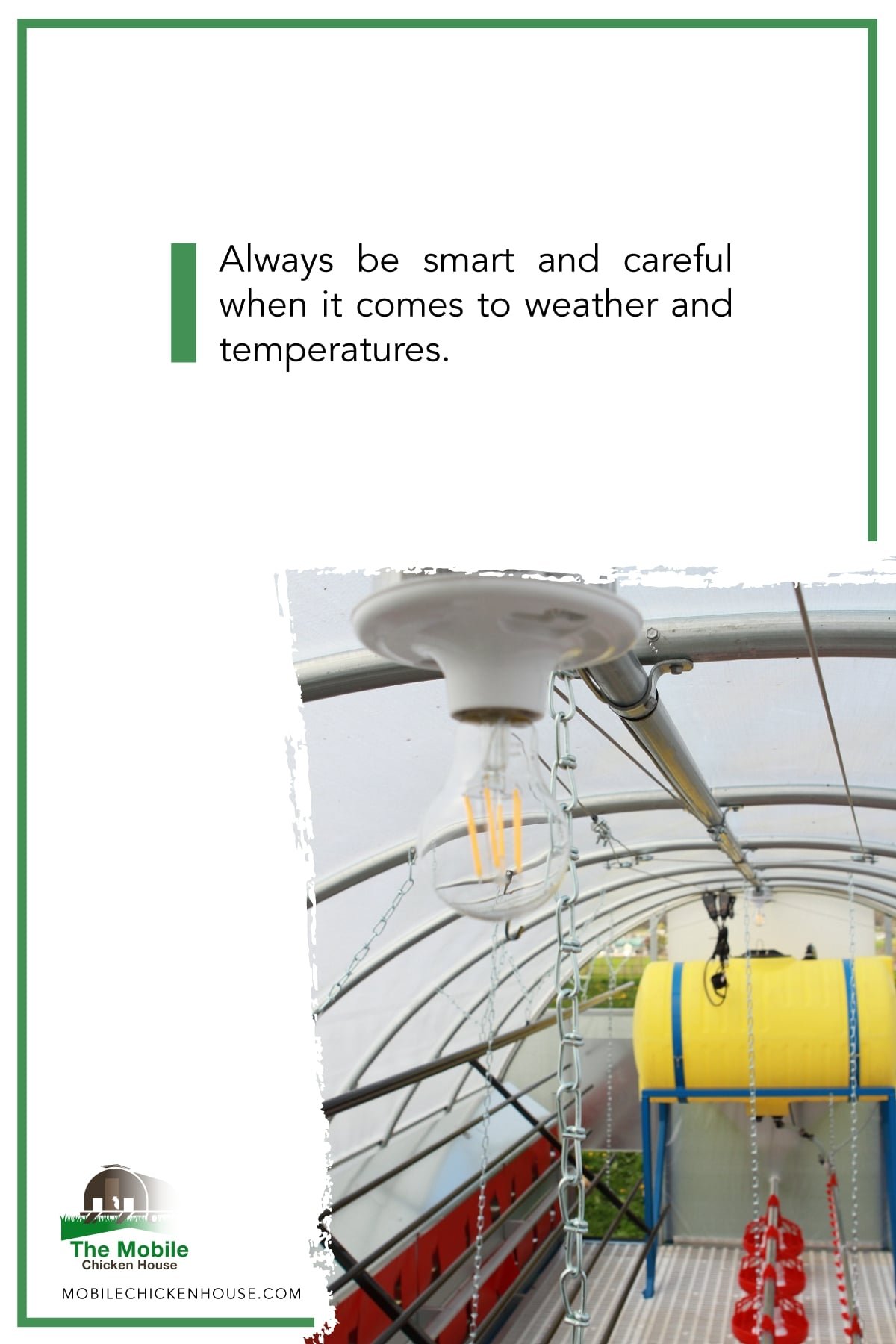
Preparing Your Mobile Chicken House
Before your hens arrive, there are several things you need to do to ensure the training goes as smoothly as possible.
How old should the chickens be?
Like any animal, chickens are easier to train the younger they are. We recommend training your flock when they are pullets around the 16-18 week mark.
Training your flock when they are young develops patterns that make your mobile-pastured egg operation successful as long as you have the flock.
Have your mobile chicken house completely ready
Before your new hens arrive, make sure the house is entirely ready to go.
Make sure your house is completely stocked with fresh water and a good feed supply. If you are using a model from The Mobile Chicken House, we design our houses to have enough food and water to last several days.
If it is a new mobile house, make sure all the functions are working correctly and the construction is complete. You don’t want to be troubleshooting or finishing something on the mobile coop while the hens are in training!
If the house has been used for a previous flock, then make sure it is thoroughly cleaned out, has no maintenance issues, and is ready to go again.
Have easy access to the pasture area
The mobile house needs easy access to the field where you will be pasturing your hens.
While you don’t need to have the chicken house in the pasture when the flock arrives, you also don’t want to travel a long distance with the hens in the mobile house. Therefore, make sure the house will have short and easy access to your field or pasture.

What To Do When Your Flock Arrives
Once your house is ready to go, you are prepared for the flock’s arrival. Here are the first things to do when your new flock arrives.
Put your hens into the mobile chicken house and close all the doors
You must put all the hens into the chicken house immediately when they arrive and do not allow them outside access!
For most hens, the chicken house is a new experience, and they need to learn where the water and feed are, where to roost, etc.
To teach them this well, they need to be inside the chicken house and not be allowed to leave the house whenever they want.
Also, depending on the number of chickens you have and the house size, it will be somewhat crowded. Make sure you follow the manufacturer’s suggested number of hens, or you will run into issues caused by overcrowding.
At The Mobile Chicken House, our current models hold either 650 hens or 300 hens.
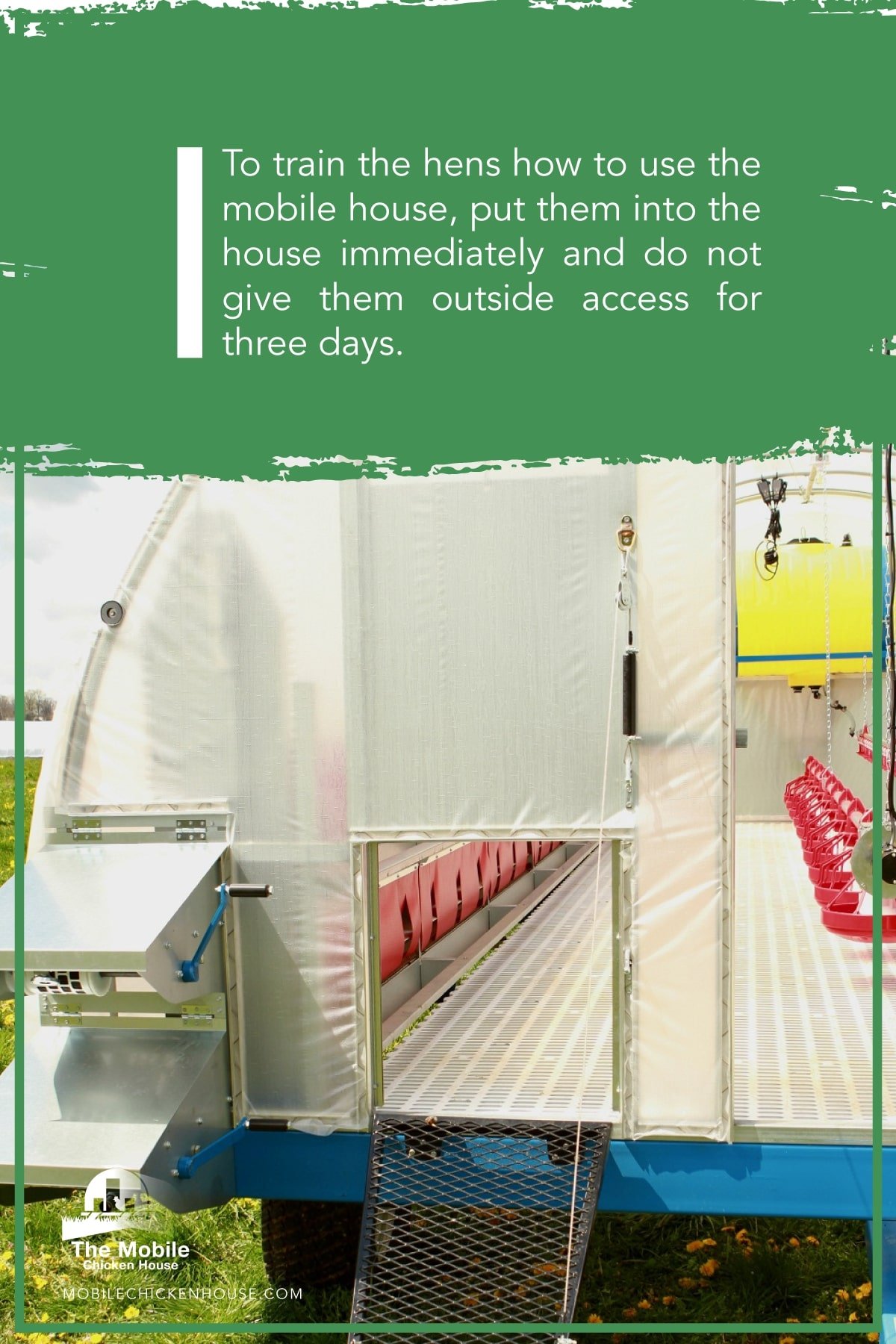
Keep nests closed if they are not laying hens
If the flock is new and not yet laying eggs, you also want to prevent access to the nests.
This not only trains the hens where the proper roosting areas are, but it also helps prevent damage and other issues from hens overcrowding the nests.
Keep the flock inside the house for three days
Yes, we know, this is a long time!
During these three days, it is critical that the hens do not have outside access. Instead, they need to continue acclimating to their new home.
Remember, the new chickens must learn where the feed, water, and roosting areas are in the mobile chicken house to be properly trained. In our experience, three days is usually sufficient time to train the flock on the locations of these essentials.

Transitioning To The Pasture
After the hens have been in the house for three days, it’s time to introduce them to the mobile-pastured portion and continue their training.
Find a place where the house can be parked for three days
The “mobile” portion of the training typically takes a new flock three days to learn. During these three training days, you don’t want to be moving the mobile chicken house.
Therefore, you need to have a good pasture area that can handle the chickens for three days. Natural vegetation should be adequate, and the ground needs to be able to handle the chicken manure during this time.
Another thing to consider is choosing an area with few distractions. The fewer initial distractions the hens encounter outside, the faster they learn. Common distractions to avoid are trees, bushes, buildings, or large fence posts.

Put a wire fence around the house frame before letting them out
Many hens naturally want to go under the house at night during training, and this needs to be prevented immediately. It is critical to train the hens to enter the house to roost, and therefore going under the house must not be an option.
To keep hens from going under the mobile house to roost, we recommend installing a simple, temporary fence around the frame of the mobile house.
This is easily done by using fiberglass fence posts to hold 2x4” wire, or something similar, at the height of 2 feet.
Once the flock is properly trained to roost inside the house, this temporary fence will be removed.
Day 1 At Pasture
If your flock has arrived at this point, then congratulations, you are ready to begin the “mobile” part of their training!
The first day has two main goals:
- Teach the hens to use the chicken house doors and ramps to go outside.
- Make sure all hens roost inside the house at dusk.
Please remember to be sensitive to the temperature and weather during this time since the flock will be exposed to the outside elements for the first time in several days.
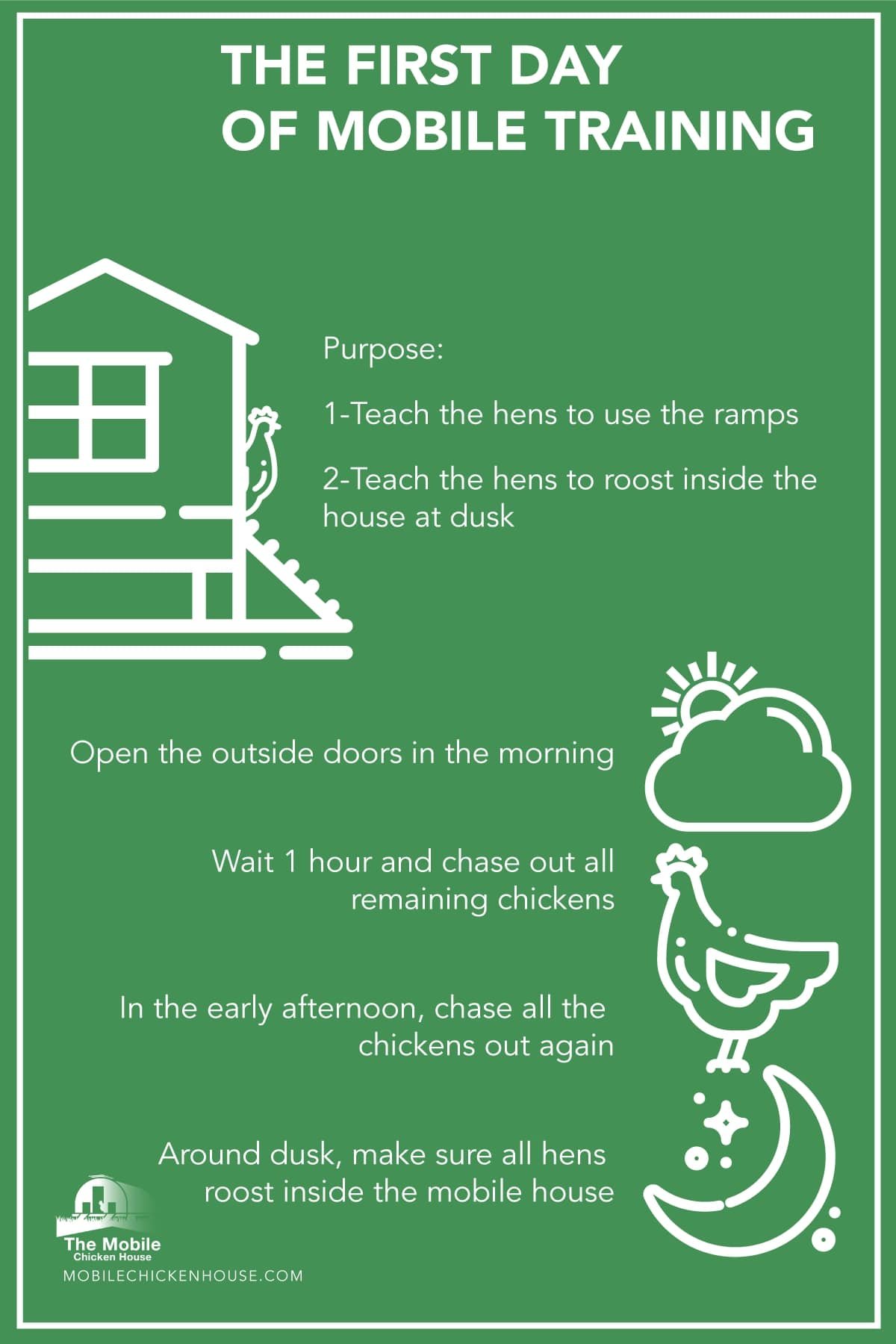
Open the outside doors in the morning
This is it - the hens are finally allowed outside of the house! Sometime in the early morning after dawn, open the doors to the mobile house.
Wait 1 hour and then chase out all remaining chickens
Unless the weather is bad, we have found most of the hens have gone outside after 1 hour. However, there are usually some chickens that are afraid of the new outdoors and prefer staying inside the house.
Chase all the remaining chickens outside of the house. The goal is to teach every hen about the outside access and how to use the external ramps.
In the early afternoon, chase all the chickens out again
Many of the hens will have reentered the house at some point for water, food, or shade. Like the morning, some hens will have settled down inside the house.
Sometime in the early afternoon, walk through the house again and chase all the hens out of the mobile chicken house to continue training them to use the doors and ramps.
Around dusk, make sure all hens are in the mobile house
It is critical to teach the flock to roost inside the mobile chicken house and not stay outdoors! This protects them against long-term issues with predator control, weather issues, and colder temperatures.
If the hens had the suggested three days to acclimate to the house earlier, then most of them will have returned to the house to roost by dusk, but sometimes it takes them several days to learn to roost inside the house.
Around dusk, while the hens are returning to the house and beginning to roost, walk around the house and observe the chickens. You want to help train them to roost inside the house, but “picking them up and putting them into the house” is not a good teaching tool for this.
Watch for hens making small groups outside the house. If you see this, break the groups up and try to herd them towards the house.
The end goal is to have all the hens enter the house by themselves. You may need to herd some of them, but the goal is essential: The hens need to learn to enter the house to roost and not stay outside!
Also, double-check your fence around the house to make sure no hens slipped through to roost underneath the house.
Close the house doors or have predator control
To protect your hens during the night, make sure you close the chicken house doors or introduce predator control. Some farmers like the security of having both - an animal for predator control and closed house doors.
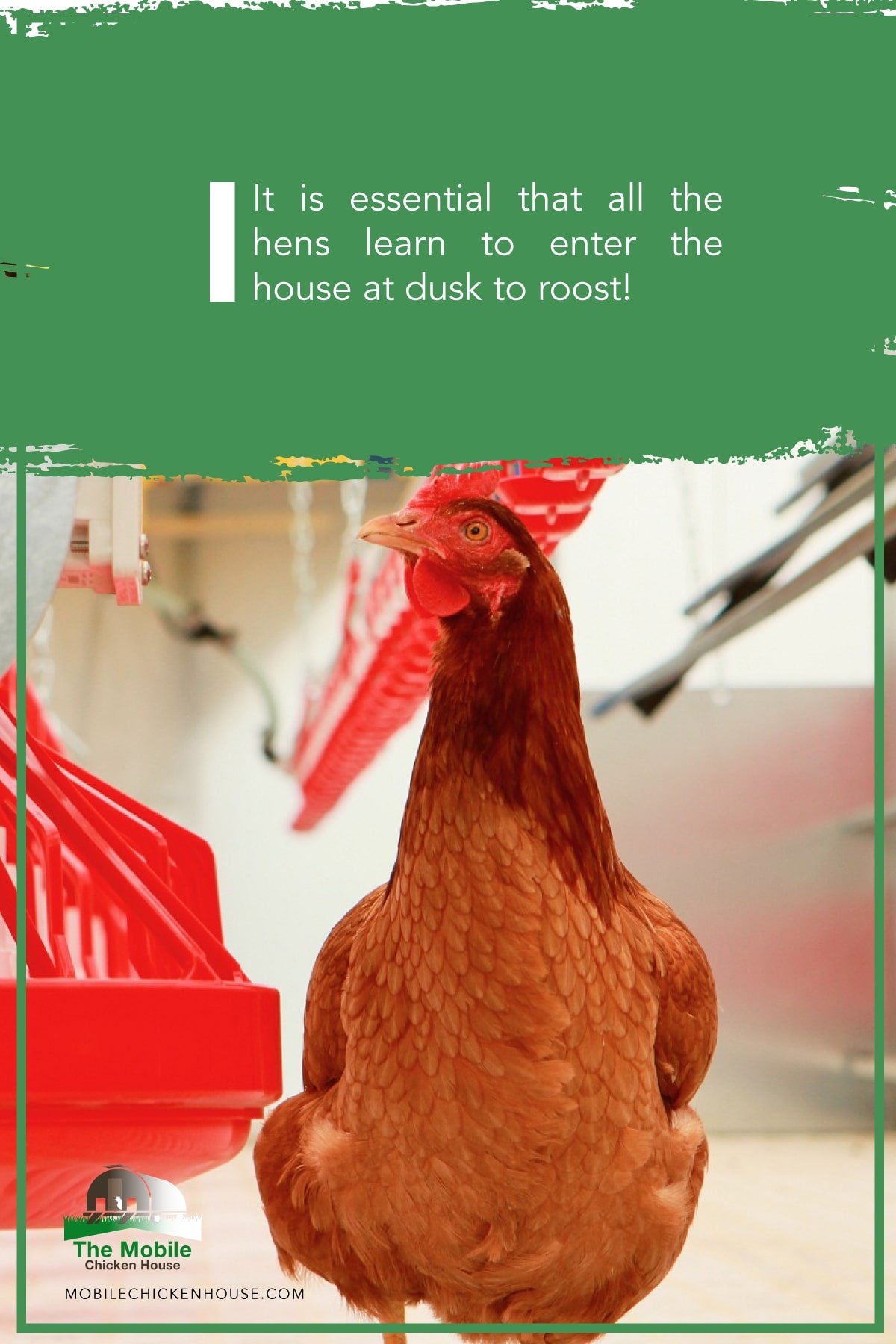
Day 2 At Pasture
The second day follows a similar pattern to the first day.
Open the outside doors a little after daylight
On the second day, you want to open the doors a little after daylight. If your house is equipped with a daylight sensor or timer, this can be done automatically without you being at the house.
Wait 1-2 hours and chase out all remaining chickens
Like the first day, have someone visit the house 1-2 hours after the doors open to chase out all the remaining chickens.
In the early afternoon, chase all the chickens out again
Even though many of the hens should be used to the ramps by now, make sure every hen continues adjusting to the doors and external ramps.
Around dusk, make sure all hens are in the mobile house
Just like the first day, you need to have someone walk around the house at dusk to make sure all the hens are safely inside the house.
Close the house doors or have predator control
Once you have ensured that all the hens are inside, close the doors to the mobile chicken house, or make sure your predator control is present.
Day 3 At Pasture
By the third day, most of the hens should be getting used to the cycle. Observe your flock carefully on day 3 to see how well they are learning.
Open the outside doors a little after daylight
Similar to Day 2, you want to have the doors open soon after daylight.
Wait 1-2 hours and chase out all remaining chickens
Most of the hens should be used to the ramps and doors of the house, but chase them out one last time to make sure the training is finalized.
Arrive a little before dusk and observe the chickens
On the third day, arrive at the house a little earlier than the other evenings and observe your chickens.
If the majority of the hens understand the need to go inside the house to roost, then you know the training is almost complete. While there may still be a few hens that you need to place inside the house manually, the goal is to have most of the hens entering the mobile house and roosting on their own.
If most of your hens are entering and roosting on your own, then congratulations, your flock should be trained and ready to be moved regularly!
If there are quite a few hens not entering the house on their own yet, then observe the flock at dusk for a few more evenings. This is especially critical if you remove the temporary fence around the house, and you see hens roosting under the mobile house.
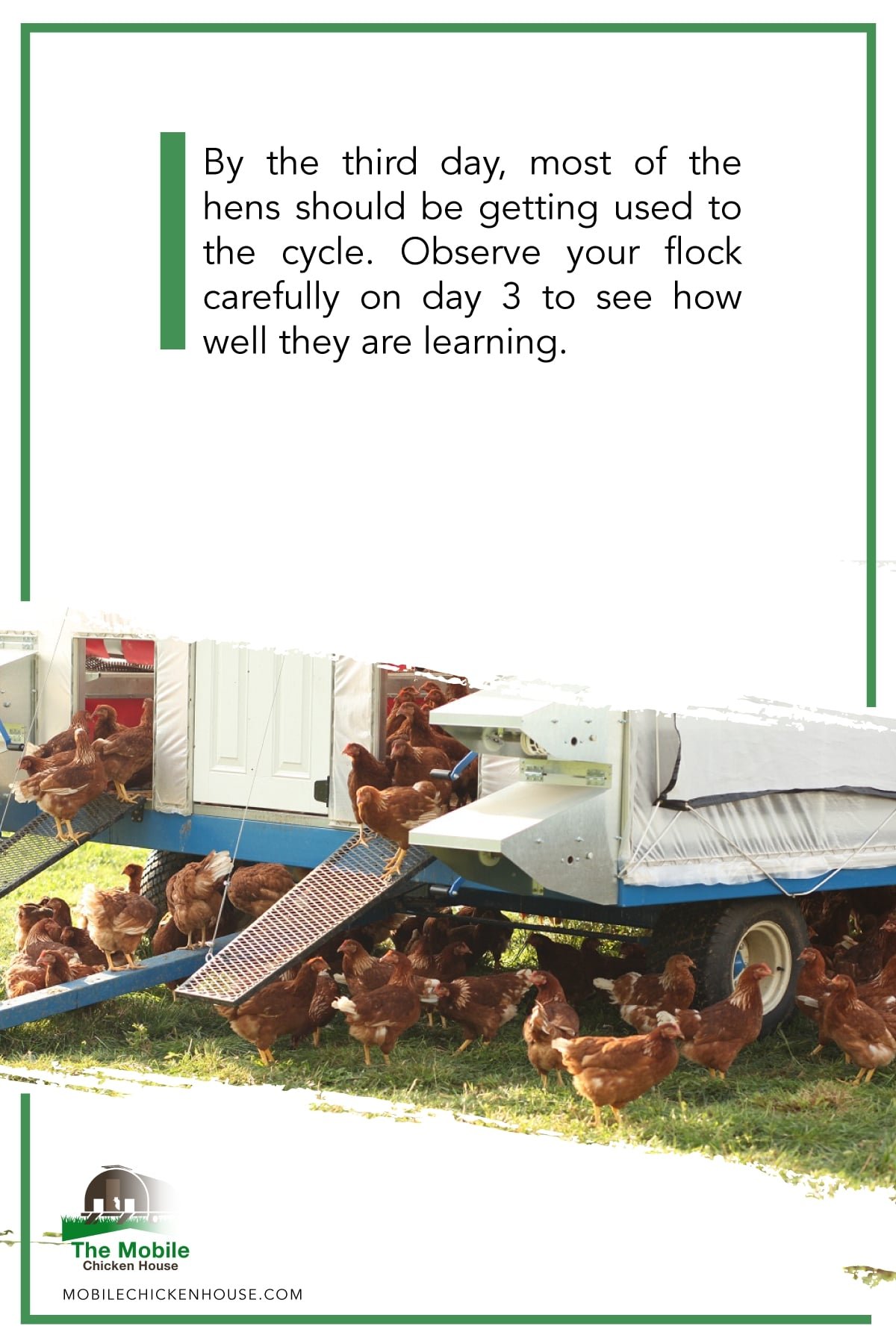
Day 4 At Pasture
By day 4, your flock should be trained and ready to be a fully mobile-pastured flock!
Remove the temporary fence
Make sure you remove the temporary wire fence around the house before you move it. During the day, hens will go under the mobile house, which is fine as long as they don’t roost under the house at night.
Begin your regular movement schedule
You can begin regularly moving your mobile chicken coop at this time. This stage makes your flock a true mobile-pastured egg operation!
If you have automated doors, close them 30 minutes after dark
If you close the house doors at night, we recommend closing them 30 minutes after dark. This allows any stray hens to get inside before the doors close.
As we mentioned earlier, if you noticed hens still struggling to roost inside the house, then make rounds at dusk for a few more evenings until every hen is trained to roost inside.
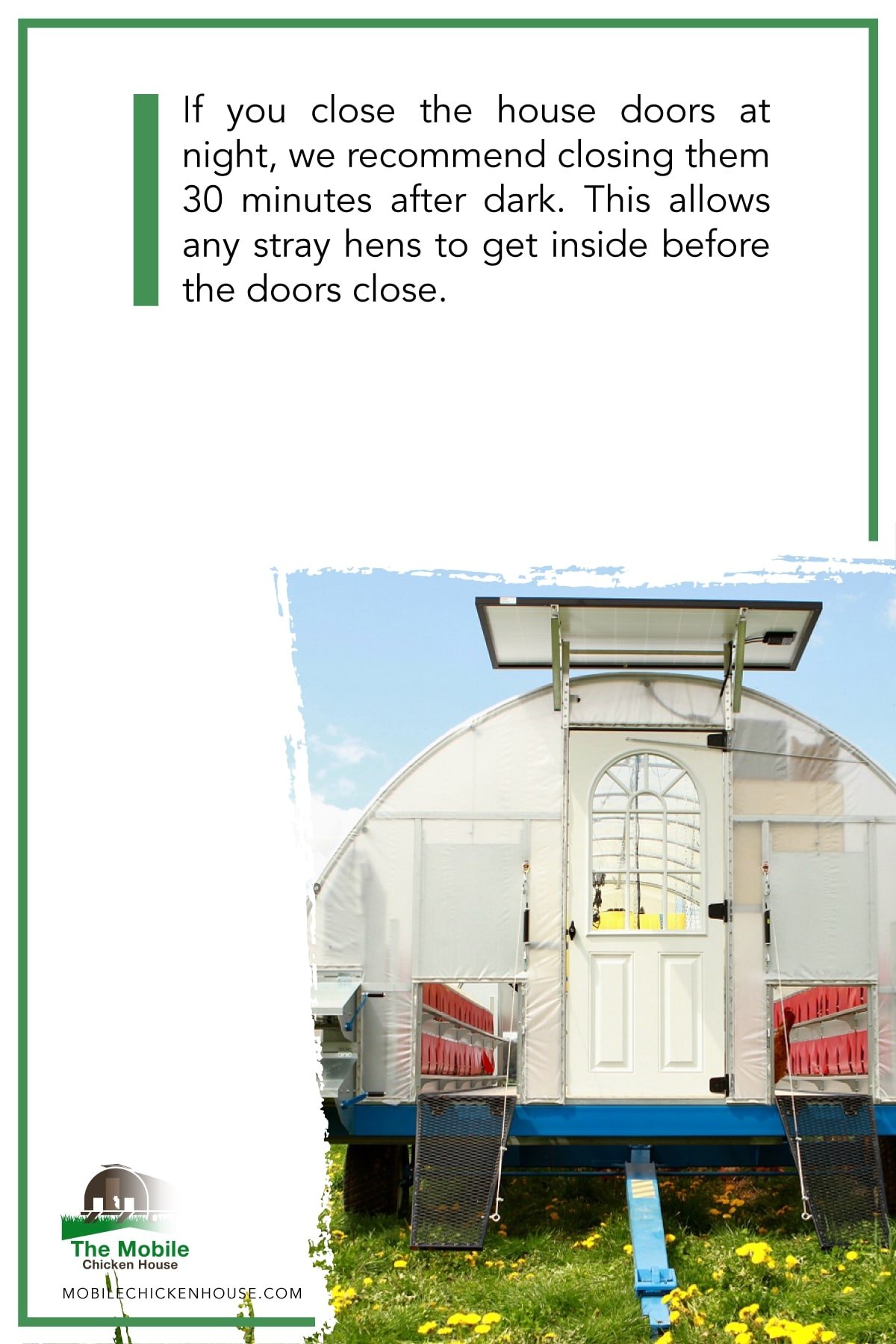
Conclusion
Having a trained flock of chickens with your mobile chicken house provides the ultimate efficiency and saves time and energy for a mobile-pastured egg operation.
Other than the time needed to gather the eggs, move the house, and periodically fill the water and feed, your flock is able to take care of itself.
Do you want to learn more about mobile-pastured egg operations and the benefits of this type of farming?
If so, read our blog article on the complete guide to the benefits of mobile-pastured eggs.
And if you are ready to get a quote on an efficient mobile chicken house designed to lower your labor costs while increasing your egg production, then get a quote today for one of our available models.
The team at The Mobile Chicken House has over 10 years of experience in operating a mobile-pastured operation, including training chickens and building our own houses.
We have taken these 10+ years of experience and used them to create mobile chicken houses that make the egg operation as efficient and labor-saving as possible.
We look forward to hearing from you and making your egg operation more efficient!

